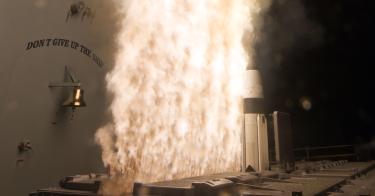You can be the best shot in the world, but your expertise won’t count for much if you run out of bullets. The same principle holds true for a country’s armed forces. Just ask the U.S. Navy. It’s getting low on munitions—yet the Pentagon is refusing to ask for sufficient supplies to replace them.
The U.S. Navy Has a Munitions Problem
Fighting the Houthi terrorists for almost a year hasn’t helped. On July 19th, Houthi-launched drones struck Tel Aviv, Israel, potentially targeting a U.S. consulate. The Eisenhower Carrier Strike Group had been countering their attacks on Israel and international shipping for nearly nine months, until their deployment ended on July 14th—five days before the attack on Tel Aviv, demonstrating the lethal consequences of being unable to intercept these attacks.
While the personnel in the Eisenhower Carrier Strike Group proved their valor, their nine-month deployment illustrated what a key problem this persistent munitions shortage has been for the U.S. Fleet. And Congressional Appropriations bills for FY-2025 defense funding promise little in the way of relief.
The U.S. Navy provided a detailed list of key munitions used by the Eisenhower Carrier Strike Group during its deployment: 155 Standard Missiles, 125 Tomahawks, and nearly 60 air-to-air missiles. And these numbers may not include munitions launched by other U.S. warships attached to the Eisenhower Carrier Strike Group, such as the USS Carney, the USS Laboon (both destroyers), and the USS Florida, a submarine.
>>> 5 Key Steps Congress Must Take To Revitalize U.S. Maritime Strength
So how much of our total munitions did this represent? While the U.S. military’s precision-guided munition inventory level is classified, various estimates place the total U.S. Tomahawk Missile inventory at roughly 4,000 Tomahawks prior to the Eisenhower Carrier Strike Group’s munition expenditures against the Houthis. That means that 125 missiles represent more than 3% of the U.S. arsenal. The mathematical maximum number of Standard Missiles in U.S. inventory is 11,000, meaning that those 155 Standard Missiles constitute roughly 1% of the maximum U.S. inventory—more likely closer to 2%, due to arsenal age and attrition. That’s a lot considering the relative strength of the Houthis to China, and that most of those Tomahawks were used in less than a day.
In a war against China, these munitions are critical. The U.S. needs those munitions. The Houthis are a comparatively small, less advanced, and less lethal threat than China, yet they’ve proven to be a persistent problem for the U.S. and its allies. If it takes hundreds of missiles to blunt Houthi attacks—with limited success—it will take even more to face the threat from China.
Expending munitions against the Houthis would be less damaging if the U.S. was backfilling those munitions in a timely manner. But we’re not. In 2023, the U.S. military procured 68 TLAMs, 125 SM-6, and 619 Sidewinders. For FY-25, the Pentagon requested just 22 TLAMs, 125 SM-6, and 362 Sidewinders. At the precise moment that the U.S. needs to increase its Standard Missile and TLAM inventory, both are declining when taking into usage in the Red Sea.
What Can the Navy Do?
The Pentagon and Congress should remedy this immediately by boosting the procurement of vital U.S. munitions in the pending defense appropriations bills. Unfortunately, the Pentagon is not asking for a significant change in munition procurement relative to prior years, and Congress is not only failing to increase munitions orders significantly, it is actually discussing procuring less munitions while denying the use of multi-year contracting authority. That is despite wargames showing that the U.S., in a war with China, would run out of key munitions in about a week.
>>> The Prioritization Imperative: A Strategy to Defend America’s Interests in a More Dangerous World
One reason the Pentagon cites to justify insufficiently large munitions orders is a lack of U.S. industrial capacity to handle larger orders. America’s ability to boost missile production in the short-term does not exist, the Pentagon claims, and therefore procurement shouldn’t be elevated. But in some instances, the claim that the U.S. military is buying as many munitions as industry can produce is undermined by their own procurement asks. For example, U.S. TLAM procurement and procurement requests have declined from over 200 per year to 22—in less than a decade.
Regardless, industry capacity shouldn’t be a barrier for the Pentagon to procure key munitions. Without sustained demand for these missiles, industry has no incentive to increase its production. After a decade of the Great Depression, the sustained demand signal led to increased output and the eventual and successful military rearmament that allowed the nation to persevere in World War II.
As historian Arthur Herman put it, “All you had to do was put in the orders, finance the plant expansion, then stand back and let things happen.” Rather than placing small, inconsistent orders with industry, Congress and the Department of Defense should place large, consistent orders for key munitions using multi-year contracts.
It is imperative that the U.S. boost production and procurement of precision guided munitions immediately. From contract award to delivery, it can take years to build key precision guided munition. To increase the magazine depth of key munitions by 2027—a frequently cited date for a possible Chinese invasion of Taiwan—procurement and production must begin now.
The Pentagon and Congress know there is a munitions shortage. It’s time for them to fix it.
This piece originally appeared in the National Security Journal




